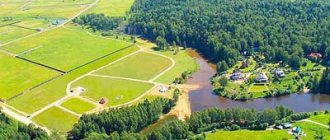The territory of the country is divided into lands:
- settlements;
- agricultural purposes;
- natural reserve areas;
- forest lands;
- water spaces;
- special purpose;
- stock.
Read more here: 7 categories of land, their codes and intended purpose.
Theoretically, the entire territory is divided into plots and a category is defined for each, since it is this that is the basis of accounting information about the land.
But in reality, it is often discovered that there are unzoned arrays or that this characteristic is missing from the documents. This defect must be corrected as quickly as possible.
Required documents
- Passport;
- Title documentation;
- Cadastral passport;
- Certificate confirming land use rights.
[title3] => Changing the VRI of a land plot in “Lenoblkadastr” [text3] =>
The cost of the service changing the type of permitted use consists of two factors: payment of the state fee and the work of our specialists. Therefore, the final price for changing the VRI is calculated personally, depending on the complexity of the order.
Advantages of contacting our company:
- We travel to any district of the Leningrad region;
- We have been working for more than 10 years and have many positive reviews;
- We bear full responsibility for the quality of services provided;
- We work in close cooperation with all licensing authorities;
- We do not use the services of intermediaries.
Do you need to change the type of permitted use of the land? Call! We will carry out the procedure without refusals or bureaucratic delays.
[micro_product] => 0 [block_image] => 0 [service_content] => [sale_percent] => [price_old] => [sale] => [node_type] => service [node_id] => 4163 ) [text] =>
The types of intended use of land plots are established in accordance with the current classifier. If the category of land is not established, land use is considered non-targeted, which entails legal consequences for the owner. At best, it will not be possible to register the objects built on the site; at worst, monetary fines will be imposed. Therefore, determining the category of land plots is an integral part of land use.
The procedure for assigning a site to a certain category involves a number of difficulties that are difficult to understand without the help of a qualified specialist. Cadastral engineers will help establish the category of land for plots located in St. Petersburg and the Leningrad region. We have been solving such issues for more than 10 years; individuals and organizations can order the service.
) The category of land has not been established: what to do and how to establish the category of a land plot
St. Petersburg, st. Borovaya, 8, lit. I, paragraph 5
- About company
- Clients and reviews
- Contacts
- Prices
+7
+7 (812) 448-47-12
- home
- Cadastral services
- Change of VRI
- Land category is not established Land category is not established
The types of intended use of land plots are established in accordance with the current classifier.
If the category of land is not established, land use is considered non-targeted, which entails legal consequences for the owner. At best, it will not be possible to register the objects built on the site; at worst, monetary fines will be imposed. Therefore, determining the category of land plots is an integral part of land use. The procedure for assigning a site to a certain category involves a number of difficulties that are difficult to understand without the help of a qualified specialist. Cadastral engineers will help establish the category of land for plots located in St. Petersburg and the Leningrad region. We have been solving such issues for more than 10 years; individuals and organizations can order the service.
Price
to order RUR
The exact price will be determined after calculation
What has changed in the categorization of NVOS?
The new criteria take more into account the type of economic activity than the volume, compared to the canceled Resolution No. 1029 of September 28, 2015. For example, food production facilities belong to category I, regardless of productivity.
Exceptions:
- production of sugar beet products - daily or quarterly volumes are preserved for it
- facilities with local treatment facilities that comply with the requirements of environmental legislation on wastewater discharges are classified as category II
- food packaging is an activity excluded from the criteria.
Performance accounting has been retained for most categories, including activities in the field of waste management, but the quantitative criteria have changed. The legislator also clarified the wording in the transfers, replacing the conjunction “and” with “and (or).” That is, to be assigned to a certain category, it is enough to fulfill at least one of the specified criteria, and not their totality.
Let's take a closer look at the changes.
Category I
1. Supplemented with objects:
- for the extraction or preparation of titanium ores
- disposal of waste of I and (or) II hazard classes, III class (500 tons or more per year)
- on coal preparation.
2. Objects excluded:
- production of pharmaceutical substances (transfer to category II)
- food packaging
- performing work on slaughtering animals, if there are local treatment facilities.
3. Quantitative criteria for objects have been clarified:
- production of refractory ceramics, porcelain products
- waste management of I - III hazard classes
- production of sugar beet products
- poultry breeding
- raising pigs.
II category
1. Supplemented with objects:
- supply of electricity, gas and steam with an installed generating capacity of less than 250 MW and more than 3.5 MW - on solid or liquid fuels, less than 500 MW and more than 7 MW - on gaseous fuels
- for mining, if the object is not classified as category I and common minerals
- providing thermal energy with fuel combustion, with a design thermal capacity of less than 20 Gcal/hour and more than 3 Gcal/hour; more than 3.5 Gcal/hour - on solid and liquid fuels; more than 7 Gcal/hour - on gaseous fuel
- for the production of plywood, particle boards and fibreboards
- for transportation using interfield pipelines, as well as for transshipment of oil and petroleum products, their discharge (loading) on unloading railways
- for the production of rubber products from rubber mixtures
- waste disposal of IV and V hazard classes using thermal methods (with a design capacity of less than 3 t/hour)
- recycling and neutralization of waste of classes I - III in low-power installations, including mobile installations
- waste treatment of classes I - III
- waste disposal of classes IV and V (except for the use of thermal methods)
- for the production of concrete mortar and asphalt concrete mixture
- performing work on slaughtering animals, if there are local treatment facilities
- for the production of pharmaceutical substances
- infrastructure of ports, seaports, railway transport that do not meet the criteria for category IV.
2. Quantitative criteria for objects have been clarified:
- production of refractory ceramics, porcelain products
- waste management
- production of sugar beet products
- poultry breeding
- raising pigs
- warehousing and storage of oil, petroleum products, agrochemicals
- production of concrete products.
Please note that almost all waste management activities are now categorized as Category I or II. Exception: processing of waste of classes IV and V.
III category
Added with objects:
- disposal of waste, after complete completion of liquidation and (or) reclamation work, excluding negative impacts on the environment, before deregistration
- waste treatment of classes IV and V
- work on subsoil areas, use of water bodies, if the objects are not classified in other categories
- for groundwater extraction, if the object does not meet the criteria for category IV
- construction of capital projects lasting more than six months.
IV category
The legislator introduced a new criterion for classifying objects into category IV while simultaneously meeting other conditions: “no emissions of pollutants.” Thus, it has reduced the number of unaccounted economic activities that can have a negative impact on the environment.
Other additions to objects:
- production, including for own needs, of electricity (with a design electrical capacity of less than 1 MW) and hot water (with a design thermal capacity of less than 2 Gcal/hour), subject to the absence of discharges of industrial wastewater and pollutants
- extraction of groundwater, in the absence of emissions of pollutants into the air, discharges into the environment, or for the purposes of drinking, domestic water supply and (or) technical water supply (with a production volume of less than 500 cubic meters per day)
- construction of capital projects lasting less than six months.
The legislator excluded the wording “gaseous fuel” from section 4. Now all boiler houses that meet the criteria belong to category IV.
You can download an object-by-object comparison of changes in the NVOS criteria from the link at the end of the article.
What does it mean that a site has no category?
All land plots located on the territory of Russia are divided into target groups that determine the possibility of their use. In total, the classifier identifies 7 categories:
- Agricultural purposes;
- Settlements;
- Industrial zones;
- Territories under special protection;
- Forestry enterprises;
- Water management:
- Reserve funds: unallocated lands owned by the state.
Within each group, an additional classification is provided that determines what exactly can be done in the allocated area. For example, engage in construction, conduct agricultural activities or farm. If the category of a land plot was not established for some reason, this plot does not have a intended purpose. Consequently, any use of such a site is considered unauthorized.
Changing the purpose of a land plot
In order to make changes, sufficient grounds are required. For example, adjustments regarding the area of the site, the construction of buildings, during the construction of roads, the construction of an industrial facility on this territory, etc. The legislative basis for changing the category of land is contained in the Land Code of the Russian Federation, in chapters from to and 2 of the Federal Law No. 172 of December 21, 2004 “On the transfer of land...”.
Changing the category of land is carried out by the same bodies that were involved in establishing it according to the group of territory. For private areas, this is done by local municipal authorities.
In order to make changes you will need:
- Submit a corresponding application to the authorities. The application must detail the reasons for the change.
- All necessary documents are attached to the application. Namely: a certificate from the Unified State Register of Real Estate, a conclusion from ecologists, a copy of the passport, documents confirming ownership of the site, and the consent of all copyright holders to change the category.
- It is necessary to receive notification of the decision of the special commission on the change.
- Subject to approval of the application, it is necessary to make changes to the cadastral registration.
- If the application is not approved, it can be contested.
How to find out whether a category is installed or not
The following options are available for this:
- Territorial authorities - these structures are involved in the redistribution of the land fund, so information about the site may be contained in the relevant acts;
- Owner's documents - ownership rights, purchase and sale agreements, donations or leases;
- Extract from the State Cadastre - registration certificate, cadastral passport, etc.;
- Certificate of registration of real estate - the main characteristics of the land plot are usually indicated here, including the assigned category.
If the documents in the hands of the landowner do not contain the information of interest, it is better to entrust the research to qualified specialists. Our cadastral engineers will help you prepare and send requests to all the necessary authorities, saving you from wasting your time.
How can I find out from the documents?
The definition of the category must take place in any official documents that talk about land as an object of law. There are a lot of them.
- Documents of power structures of various subordination: federal, regional (regional), municipal - on the allocation of land for the individual needs of citizens. A typical example is a document of ownership of allocated land.
- Agreements on the purchase and sale of land, its exchange, lease, etc.
- Information from the State Real Estate Cadastre: passport, extract, Unified State Register of Lands and others.
- Document on state registration of rights to real estate. The main characteristics of the land are also indicated here.
- Other official documents in which the area of interest appears. Let's say, an act on the seizure of land due to its inappropriate use, etc.
The documents that the owner has must duplicate all other official information.
If the category is included in the owner’s papers , but there is no mention of this in the State Real Estate Cadastre, the state real estate cadastre, at the owner’s request it is included in the official papers.
Another option is when different documents contain different characteristics .
The category of the site, at the request of the copyright holder, is determined by belonging to one of them. In this case, they rely on information from documents confirming ownership .
Perhaps the category of land has not been established at all. That is, it is not written down anywhere. Then a regulatory decision must be made by the local legislative authority to determine the category of a particular site. The basis for the decision is the owner’s petition indicating the planned purpose of its operation.
automatically classified as a settlement . All others receive a category as determined for them by law.
It is rare, but it happens that in the official data of the State Property Committee there is an entry: “land category has not been established.” This is an exception to the rule , and happens temporarily - until a decision is made.
Prices:
| Services | Price |
| Land surveying (cadastral survey, diagram, approval act, formation of a land survey plan) | from 12000 ₽ |
| Submission and receipt of documents to Rosreestr (by power of attorney) | from 4000 ₽ |
| Extract from the Unified State Register (1 piece) | from 250 ₽ |
| KPT from USRN (1 pc.) | from 400 ₽ |
| Retrieving documents from the archive | from 5000 ₽ |
| Obtaining an extract from the land use and development regulations (land use and development rules) | from 5000 ₽ |
| Consultation with a cadastral engineer (in 30 minutes, free upon conclusion of the contract) | from 500 ₽ |
Legal consequences of the absence of a target category for land
If the land plot is not classified into one of the 7 categories, the intended use of the site is prohibited. This means that the owner not only cannot engage in construction, agriculture or other activities on the site, but the plot itself cannot belong to anyone.
As a result:
- The decision to allocate a plot of land for ownership is considered illegal;
- The legal regime of use is established as inappropriate;
- Civil transactions concluded with the site become invalid.
It is impossible to register such a land plot in Rosreestr. Moreover, the state can alienate such land in its favor as a reserve fund, offering compensation to the owner.
How a category is assigned to a land plot
A special commission created at the request of the original owner of the plot can assign a certain category to a land plot. To do this, the territory is withdrawn from the state reserve fund and transferred to a certain region. The transfer is confirmed by a special act.
The intended purpose is determined by regional authorities based on the rational use of land resources. In the future, the determination of the land use category or its change depends on the ownership of the site.
The following bodies decide on assigning a target category to land:
- Federal property - the Russian government;
- Regional property - regional or regional authorities;
- Municipal and private property – by local governments.
Draft new rules for accounting for NVOS
The Russian Ministry of Natural Resources has prepared a draft of new Rules for the creation and maintenance of the Register of NVOS, which provides for the possibility of changing the category of an object when new criteria come into force. The document was posted on the official portal for the publication of draft regulations on May 21, 2021, and announced on the department’s website.
Paragraphs 32-33 of the draft establish that when the criteria for categorizing the NVOS change, the territorial bodies of Rosprirodnadzor ensure that the information in the registers is updated and issue the entrepreneur a new certificate of registration. Duration: 6 months from the date of entry into force of the legal acts. The active participation of the owner of the object in this procedure is not provided.
So we advise entrepreneurs who are “lucky” to get into the scope of federal environmental supervision according to the new criteria not to worry and wait for changes in regulatory regulation. There is a risk that individual Rosprirodnadzor inspectors in the regions will be tempted to hold resource users accountable for failure to submit an application to update data in the Register. The documents to which we have provided links at the end of the article will help convince them.
How to set the land category for a site
If the land does not have a designated use category, then such an allotment is considered unallocated and belongs to the reserve fund.
To assign a category to a land plot you must:
- Prepare a petition;
- Collect the established package of documents;
- Submit documents to the authorized authority;
- Wait for a decision.
It is important to understand that category assignment may be denied. This decision can be appealed in court, but it is impossible to predict the outcome of the meeting in advance. If our specialists take care of collecting documents and preparing the application, the likelihood of refusal will be minimal.
Detailed procedure
The whole process is described in the letter of the Ministry of Economic Development of the Russian Federation No. D23-3595 dated November 2, 2009. According to Articles 7 and 8 of the Land Code of the Russian Federation, any land plot is assigned to a certain category, according to its application.
The lands on which agricultural enterprises are located are classified as agricultural lands, and the territories on which settlements are located are classified as lands of settlements.
Find information about which category the site belongs to can be found in:
- Acts of federal executive authorities, acts of executive authorities of constituent entities of the Russian Federation and acts of local government bodies.
- Land contracts.
- State Real Estate Cadastre.
- Documents about state Registration of rights to real estate and transactions with it.
The most accurate way to determine this is to submit an application to the State Cadastral Register or to the Office of the State Registration Center with the appropriate request. Also, the definition of a category can be done by establishing and by attributing.
Establishment
The category is established as follows:
- A person who wants to assign a category to his land submits an application “On assigning a category of land...” to the relevant government or self-government body.
- The application, also known as a petition here, must contain a detailed description of the territory, namely: its address, current documents of ownership or use, cadastral registration number, absence of a category with an explanation of the reason for the absence or the current category that needs to be changed, state the reasons for the change.
- The application is supplemented by a package of documents: a paper confirming the authenticity of the applicant’s person, an extract from the Unified State Register of Real Estate, and the conclusion of a commission of environmental experts, if required.
- The application is reviewed within 2-3 months. After which, the applicant receives a refusal or permission.
Attribution
The assignment of a land plot to the category of land is applied in cases where it is impossible to establish.
The assignment is made by the relevant authorities related to the land:
- for lands in federal ownership, the assignment is made by the Government of the Russian Federation;
- territories owned by constituent entities of the Russian Federation - by executive authorities of constituent entities of the Russian Federation;
- for lands in municipal ownership - by local government bodies;
- territories that are privately owned - by local governments.
The Land Code of the Russian Federation does not contain established norms for the grounds and procedure for assigning land plots. And even more, the Land Code of the Russian Federation does not even contain blanket norms in this matter. But the land legislation, clause 1 of article 2 of the Land Code of the Russian Federation, contains a number of provisions on this issue.
Guided by paragraph 4 of Article 14 of the Law on Land Transfer, if information about the category is not indicated in the relevant documents, local government bodies adopt a regulatory legal act on classifying land as a certain category for the purpose of use. If the functionality of the land is not completely clear, then clause 5 of Art. 14 of the Land Transfer Law. During the attribution operation, it is worth taking into account possible changes in the legal regimes of neighboring territories.
Service cost
The price of services is calculated individually.
According to the law, the land use category is assigned free of charge, but the owner will have to pay for related services. For example, preparing a cadastral plan, establishing boundaries, etc. The final cost is formed from the total amount of work performed by LenOblKadastr specialists. The customer must pay a state duty in the amount of 30% of the cadastral value, because the land is actually allocated from the reserve fund and its category changes.
Where to go
An application to assign a category to a land plot is submitted through:
- Territorial Department of the Cadastral Service;
- Multifunctional centers;
- Rosreestr;
- Municipal authorities.
Here it is necessary to clarify that if the package of documents collected by the landowner is incomplete, the authorized authorities have the right to reject the application. By turning to LenOblKadastr for help, you order a turnkey service, therefore, saving yourself from any bureaucratic red tape. We ourselves submit documents on behalf of the customer and receive them after a decision is made.
How is the determination made?
The definition consists of assigning and describing land to a certain category for inclusion of these territories in a single cadastral register, taking into account their significance. To determine the ownership of your land plot, you need to submit an application to receive an extract from the Unified State Register of Real Estate.
Read about what a land category code is, in what cases and where it is indicated, and how it is correctly deciphered in our material.
How to set the categorization of a memory?
After the description comes the operation of establishing a category. Establishment is the documenting of the intended purpose of land (you can find out how to determine the intended purpose of a plot, category and VRI of land by cadastral number here). It is carried out by the local Administration according to your letter “On assignment of land categories...”.
- If a given territory belongs to the state, then it establishes the category.
- If it belongs to a subject of the country, then the executive body of that subject is responsible for appropriation.
- Private property and municipal lands are under the jurisdiction of territorial municipal authorities.
Read about how to use land whose category has not been established in our material.
How does the assignment take place?
Assignment refers to the activities of authorized bodies to establish the actual purpose of using a land plot, studying natural, social, economic and other factors of use, aimed at choosing the intended purpose that would correspond to the effective and rational use of the territory, as well as issuing an individual legal act on the assignment.
Attribution of a land plot to a certain category is used if it is impossible to accurately classify and establish.
Assigning a category to a land plot in LenOblCadastre
We help owners establish the category of land plot on the most favorable terms. By contacting us, you are guaranteed to receive the following benefits:
- Affordable prices – we have our own staff of specialists, we work without intermediaries;
- Efficiency - we travel to any district of the Leningrad region;
- Saving your time – we independently transmit and receive documents;
- Efficiency – we work in close cooperation with licensing and executive authorities;
- Guarantees - if we deal with your issue, the likelihood of failure is reduced to zero.
Call! Our land lawyers and cadastral engineers are always at your service and ready to answer any questions you may have.
They talk about us
SNT "Ozernoe" Prager V.A.
27.03.19
SNT "Ozernoe" expresses its sincere gratitude to LenOblKadastr LLC, represented by General Director Nikolai Vladimirovich Kushnirov, for the painstaking work done.
read more
FACT. Andrey Anatolyevich
20.03.19
We express our sincere gratitude to you for the work done over the past several years!
read more
SNT "VETERAN" Chairman of the Board
11.03.19
Dear Nikolai Vladimirovich, The Board of SNT “Veteran” expresses gratitude to the employees of the St. Petersburg region and personally to the cadastral engineer Yulia Anatolyevna Devyatilova.
read more
Dacha non-profit partnership "Marvelo" Chairman of the Board Kuzmin E.A.
01.01.70
The dacha non-profit board "Marvelo" expresses gratitude to the St. Petersburg geodetic department for its efficiency and high level of professionalism.
read more
All reviews
Licenses and certificates
Why choose us
- No extra charges or overpayments
We work strictly according to the contract. The cost of the work is specified in the contract. - Operative engineer visit
We will arrive anywhere in St. Petersburg and the Leningrad region.
- We save your time
We take care of submitting and receiving documents from Rosreestr.
- Affordable prices
We work without intermediaries. Own staff of engineers and surveyors.
- 10 years of experience
We have been working since 2009. More than 2500 completed projects
- Favorable discounts
For large orders and for regular customers, discounts apply.
Total area of our measurements for 2021
- About company
- Clients and reviews
- Contacts
- Prices
Privacy Policy
+7
We are on VKontakte Developed by TopForm ©
We will call you back within a day
Leave your details and we will call you back
by clicking the “Waiting for a call!” button I agree to the processing of personal data









